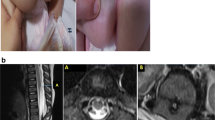Abstract
Multiple neural tube defects are relatively rare. They account for less than 1% reported neural tube defects. Cases of limited dorsal myeloschisis (LDM) and diplomyelia (two cords in single sac without intervening bony or fibrous septae) with dorsal bony spur are also a rare event. Here, the authors report a rare case of neonate with thoracic LDM, diplomyelia with dorsal bony spur, sacral meningocoele with syringohydromyelia, and low-lying tethered cord. The child also had a ventricular septal defect (VSD) and bilateral rocker bottom feet. Various environmental factors and genetic mutations in transmembrane proteins have been studied in animal models explaining the origin of neural tube defects. To the best of author’s knowledge, this is the first case of varied multiple neural tube defects with diplomyelia reported in world literature.



Similar content being viewed by others
References
Akay KM, Izci Y, Baysefer A (2002 May) Dorsal bony septum: a split cord malformation variant. Pediatr Neurosurg 36(5):225–228
Copp AJ, Stanier P, Greene NDE (2013) Neural tube defects—recent advances, unsolved questions and controversies. Lancet Neurol 12(8):799–810
Bailey IC (1971) Double meningocele. Arch Dis Child 46:549–550
Bertan V, Wilson CB (1968) Double myelomeningocele. A case report. Turk J Pediatr 10:88–90
Durmaz R, Arslantas A, Ozon YH, Tel E (2000) Double meningocele: case report. Turk J Pediatr 42:331–333
Hahn YS (1995) Open myelomeningocele. Neurosurg Clin North Am 6:231–241
Keller R, Shook D, Skoglund P (2008) The forces that shape embryos: physical aspects of convergent extension by cell intercalation. Phys Biol 5:015007
Merello E, Mascelli S, Raso A, Piatelli G, Consales A, Cama A, Kibar Z, Capra V, Marco PD (2015 Jan) Expanding the mutational spectrum associated to neural tube defects: literature revision and description of novel VANGL1 mutations. Birth Defects Res A Clin Mol Teratol 103(1):51–61
Pang D, Zovickian J, Oviedo A, Moes GS (2010 Dec) Limited dorsal myeloschisis: a distinctive clinicopathological entity. Neurosurgery 67(6):1555–1579
Rainov NG, Heidecke V, Burkert W (1995) Thoracic and lumbar meningocele in neurofibromatosis type 1. Report of two cases and review of the literature. Neurosurg Rev 18:127–134
Richards TA, Kortesis BG, Glazier S, Argenta LC, David LR (2003) Double myelomeningocele: case report and review. Br J Plast Surg 56:306–308
Singh N, Singh DK, Aga P, Singh R (2012) Multiple neural tube defects in a child: a rare developmental anomaly. Surg Neurol Int 3:147
Steinbok P (1995) Dysraphic lesions of the cervical spinal cord. Neurosurg Clin North Am 6:367–376
Tungaria A, Srivastav AK, Mahapatra AK, Kumar R (2010 Jan) Multiple neural tube defects in the same patient with no neurological deficit. J Pediatr Neurosci 5(1):52–54
Van Allen MI, Kalousek DK, Chernoff GF, Juriloff D, Harris M, McGillivray BC et al (1993) Evidence for multi-site closure of the neural tube in humans. Am J Med Genet 47:723–743
Author information
Authors and Affiliations
Corresponding author
Ethics declarations
Conflict of interest
Nil.
Rights and permissions
About this article
Cite this article
Shashank R, R., Shubhi, D. & Vishal, K. Multiple neural tube defects: a rare combination of limited dorsal myeloschisis, diplomyelia with dorsal bony spur, sacral meningocoele, syringohydromyelia, and tethered cord. Childs Nerv Syst 33, 699–701 (2017). https://doi.org/10.1007/s00381-016-3310-0
Received:
Accepted:
Published:
Issue Date:
DOI: https://doi.org/10.1007/s00381-016-3310-0




